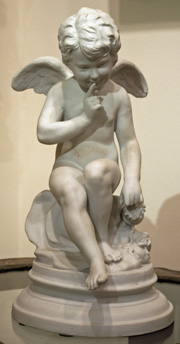About the Dishman
- Dr. W. Brock Brentlinger, at the opening of the Dishman Art Gallery, May 13, 1983
Herb and Kate Dishman
The Dishman Art Museum, then the Dishman Art Gallery, opened its doors to the Lamar University and Southeast Texas community on May 13, 1983. Herb and Kate Dishman, longstanding pillars of the community, spearheaded the campaign to expand the cultural breadth of Lamar University with the founding of a space dedicated to the research and exhibition of the visual arts. Their initial generous donation, supplemented by further financial support from the community, and the state of Texas, laid the foundation for architect Martin Gordy’s stunning two-story exhibition space, complete with offices and lecture hall.
The founding director of the Dishman Art Gallery was Dr. Lynne Lokensgard. Lokensgard had been a member of the Department of Art faculty since 1973, serving as the department’s art historian. Lokensgard stepped down as director in 2003 and retired from Lamar as professor emeritus in 2012.
Permanent Collection
The permanent collection of the Dishman Art Museum actually began two years before the opening of the museum with the generous donation of African and Pre-Colombian art and artifacts by the Petrutsas family, a collection of shields from New Guinea, donated by the Nicklos family, and the donation of Caleb and the Spies (c. 1740), painted by Mattia Preti, from Heinz and Ruth Eisenstadt.
In 1993 the museum expanded with the gift of the Heinz and Ruth Eisenstadt Collection of eighteenth and nineteenth-century academic painting and decorative arts. As part of this gift, the Dishman Art Museum expanded with a small wing built specifically to house the Eisenstadt Collection. This was accomplished under interim president and founder of the Friends of the Arts, Dr. W. Brock Brentlinger. (Dr. Eisenstadt was the organizing president of the Friends of the Arts.)
The collection continued to grow with the donation of four signed silkscreen prints by Salvador Dali in 1985. This same year, the Dishman Art Gallery also took stewardship of local artist Maudee Carron’s papers, and a large collection of her works, that span the trajectory of her career. These works, created by a local artist, remain excellent examples of both folk art and the assemblage and neo-Dadatendencies of the 1950s and 1960s. Many of her assemblages call to mind artists such as Louise Nevelson and Robert Rauschenberg. The Dishman Art Gallery continued to expand with generous donations of art and acquisition funds from the local community and Lamar alumni.
Dishman Art Museum
In 2003, the Dishman Art Gallery metamorphosed into the Dishman Art Museum. This change reflected the museum’s growing dedication towards the positive and permanent stewardship of its permanent collection and a renewed commitment to growing the museum’s collection to better serve the teaching and learning needs of Lamar University and the greater Southeast Texas community.
Continued Growth
The Dishman Art Museum continues to grow annually. The permanent collection now consists of over 1500 objects of art and visual culture. Seventy objects have been acquired since 2012. The Dishman Art Museum has produced three digital publications and four print publications since 2012.
In 2013, the Dishman Art Museum acquired six paintings from the Mandelman-Ribak Foundation. These works, created by Beatrice Mandelman and her partner Louis Ribak, two prominent Taos modernist artists, are significant additions to the collection showcasing the development of American Modernism. The Dishman also expanded its ethnographic collection with the accession of a gift from Frank Carroll of three 19th-century African works.
